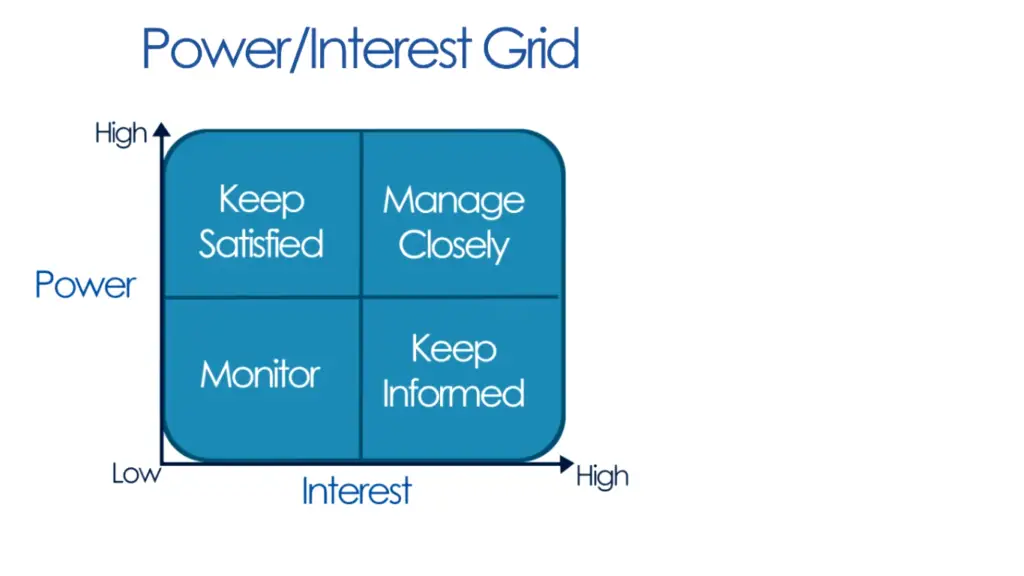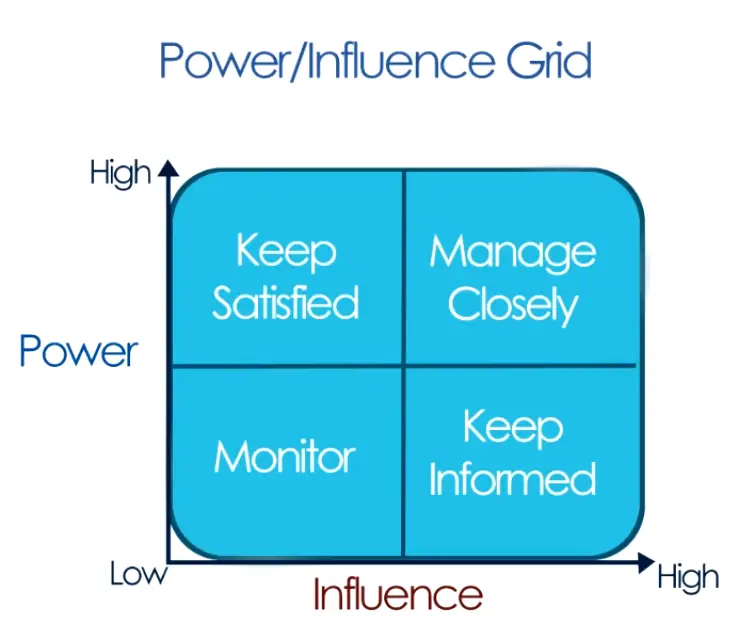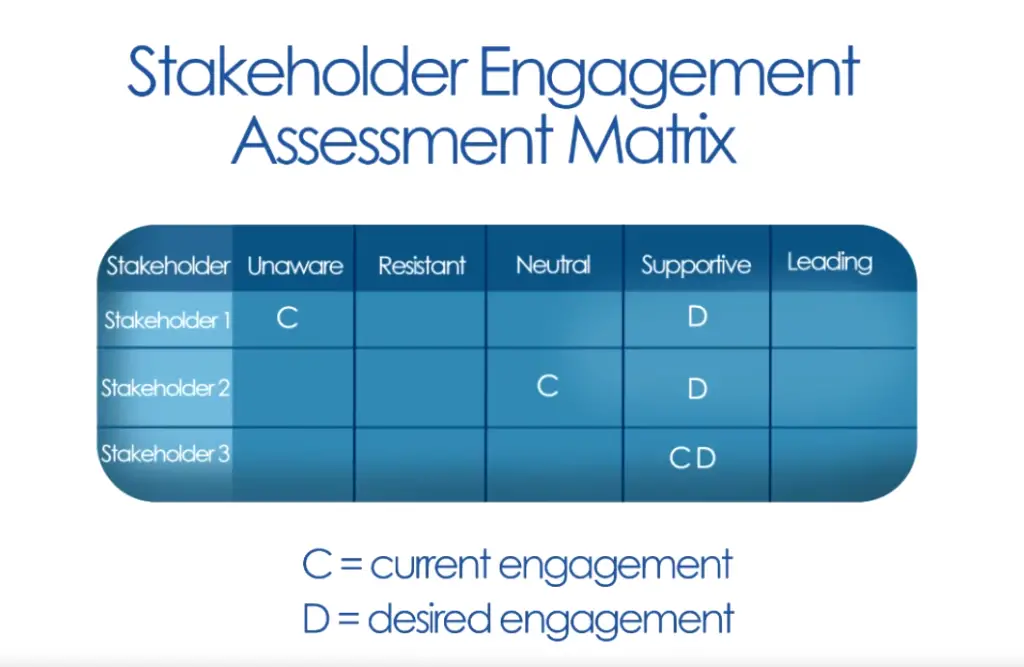Project Stakeholders
Project work is accomplished by people. Your job is to bring the right people together, get them involved and engaged, and working to cross the project finish line together. Just who, or what is a project stakeholder?
“A project stakeholder is a person or an organization, who might be positively or negatively impacted by your project.”
Now that’s a big, broad definition, and it means that your stakeholders could be a very large group. In fact, if you’re running a large project, it’s possible that almost everyone around you is in some way, impacted.
How to Identify Stakeholders
How do you know who your stakeholders are? Your stakeholders are your team members, your customers, your sponsor, your vendors, everyone involved or impacted. If you are not certain, ask these questions.
- Who asked for this project?
- Who will use the product or service we are creating, or enhancing?
- Who will have to change the way they do their jobs, because of this project?
- Who makes decisions about this project?
- Who has the ability to give or take away resources from the project?
- Who influences those who make decisions about this project?
Stakeholders Analysis
How do you know which stakeholders need more of your attention? Of course, each person is important, but you cannot give everyone the same amount of your time and attention. You need to consider which stakeholders are really going to drive project success and work towards managing and engaging those stakeholders.
You might consider using a power and interest grid to help you. This tool helps you to consider stakeholders, how much power they have over your project, and how much interest they have in your project. You use this grid to position your stakeholders in the four quadrants.
- High interest, low power, and
- Low interest, low power
- High interest, high power.
- Low interest, high power
This helps you make decisions as to how to interact with them.

- If someone has low interest and high power, you want to keep them satisfied with the project.
- If someone has low interest and low power, you want to keep in touch with them and monitor their involvement to ensure that they do not begin to take a negative view of the project.
- If someone has high interest, low power, you want to make sure that you keep them informed of project status.
- And if someone has high interest and high power, they are really where you are going to focus more of your time and attention. Manage them closely.
You can also create a power and influence grid, which is similar to the power and interest grid as discussed. In this instance, you substitute the level of influence on the project outcome and other stakeholders, in place of level of interest. You’re going to want to work diligently; to be sure you do not overlook anyone. Even if your high power, high interest group captures most of your attention, ignoring others can cause them to become difficult stakeholders.

Stakeholder Register
Now you will be thinking that what do you do with all of this information? You want to capture it in what we call a stakeholder register. A stakeholder register contains the key information about your stakeholders:
- Assessment Information
- Stakeholder Classification
- Identification Information
The purpose is not just to capture information in the register and then never look at it again. It’s a place where the information resides. The purpose of the information is so that you can strategically manage your stakeholders. A critical part of managing your stakeholders involves understanding what type of information they need, and when they need it. You also want to consider how they need it. Not everyone wants an email or a text. Some people prefer a phone call. Others would like face to face discussions. When possible, you want to try to work with those preferences.
What Stakeholders Want?
How do you know what your stakeholders want? You ask them. At the start of your project, consider interviewing your key stakeholders. Find out what is important to them. Some care more about the budget than schedule. Some care more about schedule. Some care more about quality. When you know their interests, you can understand the best ways to communicate with them. If you combine this with the other work that you did, for example, if you did create the power and interest grid, and you know that someone is highly interested, and has a high degree of power, it’s in the best interest of the project to make sure that you provide them the information they seek when, or even before they seek it. And of course, you will have regularly scheduled communications that are going to the group, like
- status updates
- Presentations
- Reviews
Manage Stakeholders
They’re all part of your stakeholder communications. Once you collect this information, you’re not finished. It’s not static; it is dynamic. As your project progresses, you’re going to learn more. And as your relationships with your stakeholders grow, you’ll understand more about them and their motivations, and you will want to adjust your approach. Your job is to manage stakeholders throughout the life of the project and to keep them engaged from start to finish. Your stakeholders are very likely to be involved in other projects and other work efforts, and it’s going to be easy for them to become distracted. You help to remind them of the importance of your project. You continue to show them the vision, and what will be different, and what will be achieved once your project has completed.
Stakeholders Engagement Classifications
There are some specific engagement classifications for you to consider.
Unaware Stakeholders
The person who is unaware, they really don’t know about the project, and what the project is providing. And your goal is for this person to learn and understand why this project is important. You at least want them to be supportive and depending on them, you might even want them to take on a leadership role.
Resistant Stakeholders
The resistant person; This person knows about your project, but doesn’t love it, they’re not in favor of it. They don’t like what your project represents, or the change it brings about. You would want to try to bring this person to a more neutral position. In a perfect world, they would become a supporter.
Neutral Stakeholders
Some people will be neutral. They are aware, but they’re neither supportive nor resistant. You do not want them to become resistant, and depending on their power and interest, or their power and influence, you might want them to become supportive.
Supportive Stakeholders
Supportive stakeholders are aware of the project and in favor of what the project brings. You want to keep these people supportive, and you want them to become, maybe leaders at least some of them.
Leading Stakeholders
And then you have those whose engagement level is considered leading. They know about the project, they’re really in favor of it. And they are proactively supporting it and working to make the project a success. And of course, you want them to keep leading. So give them the opportunity to be in involved in project successes, let them know how important they are to the project, and let them be in front of people.
Stakeholder Engagement Assessment Matrix

The stakeholder engagement assessment matrix is a good tool for categorizing your stakeholders. You use it, you know, to list your stakeholders, note their current levels of engagement, and your desired level of their engagement. This helps you to come up with a strategy for managing them. As you fill out the matrix, keep in mind the relationships the stakeholders have with you and with one another. If you may have a stakeholder who is resistant, and they have a relationship with someone who is leading a good strong working relationship, you want to partner them on some project activities. And that way, hopefully, the leading stakeholder will influence your resistant stakeholder.
Takeaways
- Be proactive.
- Engage your resistant stakeholders
- Appreciate your supportive and leading stakeholders. Do not take them for granted.
- Provide open and honest information about the true nature of the project.
- Keep stakeholders informed of critical issues.
- Ask for their help in issue resolution. And when you and the team are not able to resolve an issue, bring it to them. Take the information you have about your stakeholders and use it to create a communication plan. Follow your plan and make changes to it as needed.
- Be well organized and consistent in your approach to working with your stakeholders. When you see misunderstandings or disagreements, facilitate a resolution. Be trustworthy and build strong professional relationships.
Remember, projects are completed by working with others.